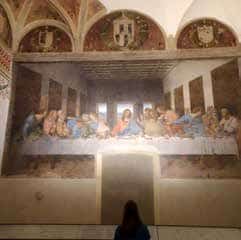Last year, my wife and I stopped in Milan, Italy, and saw the famous Leonard da Vinci mural “The Last Supper.” Interestingly, he painted it in a monastery instead of the large cathedral in town. A bombing raid by Allied forces during World War II damaged part of that monastery, but that wall — and the mural — survived with minimal damage.

Brian Kaylor
I wasn’t really sure what to expect. Just getting there had been a bit of an adventure. We learned we needed to reserve tickets well in advance, so that involved making an international call on Skype and then working through the Italian line to an English operator. Once in Milan, we made our way via public transportation to the site.
Only a small group is allowed in at any time. We made our way down a hallway and multiple secured rooms. The doors would open and we would all walk into a small room. The doors would close behind us and then new doors opened ahead for another small room to repeat the process. Apparently, this helps keep air, dust, light and other contaminants away from the mural. I almost started expecting them to give us white suits and face masks to wear like a team working with a deadly virus!
Once inside, we had 15 minutes with the masterpiece. To be honest, I went because it seemed like something we should do while in town. But I was truly impressed by the mural. Maybe it was that super clean air getting to me, but it was a moving, even holy, experience. I’ve seen images of da Vinci’s work more times than I can count, and yet it seemed different in person.
 As I reflected later about the mural, three things particularly surprised me. First, the size. With the characters larger than life, it dominated the room. The table with the disciples and Jesus runs nearly the length of the entire side of the room.
As I reflected later about the mural, three things particularly surprised me. First, the size. With the characters larger than life, it dominated the room. The table with the disciples and Jesus runs nearly the length of the entire side of the room.
Second, I marveled at da Vinci’s skill in creating a three-dimensional image on a two-dimensional surface. Unlike other times when I’ve seen images of it, in person it looked like the disciples and Jesus were sitting in a special part of the room that jutted off from the main part. The windows behind them looked as if dozens of feet away. The skill of the painter created an optical illusion.
A final ‘wow’ observation actually came from a tour guide talking to some other people in the room. We didn’t pay for her wisdom like they did, but we were smart enough to lean in close enough to listen anyway! She noted that da Vinci challenged the traditional way of depicting the last supper in several ways, such as not putting halos over Jesus or the disciples. And da Vinci changed the moment in the story when he decided to pause the action.
Many other painters focused on identifying Judas as the betrayer. But da Vinci painted the story just before that, when Jesus announced one of them would betray him. Thus, many of the disciples appear visibly shocked and anguished. They can’t believe one of them would betray Jesus, and they are hurt by this prediction. As I stared at the mural with new appreciation, I pondered the significance of that artistic choice.
Do we jump too quickly to the pat answers so that we don’t wrestle with the difficult moments or difficult texts? We “know” the answer before we even know the question. We know Judas is the bad guy so we skip ahead past Jesus’s remarks. Yet, the disciples didn’t know. Not only did they not suspect Judas, but some even suspected themselves! We do that at other moments as well. We know the Samaritan is the good guy in the parable even if we’re not quite sure what a Samaritan is. Thus, we strip the story of its shock as the racial and religious “other” arrives as the godly hero.
As we approach Easter, may we allow ourselves to be shocked by the too-familiar story. Our King didn’t demand we die for him, but instead died for us. The plan of coming as the Messiah involved riding into Jerusalem not to fight but to surrender to death. And before the glorious resurrection, it seemed God was dead. This doesn’t make sense. So, perhaps, like da Vinci, we should pause there and ponder what it means.
Brian Kaylor is editor & president of Word&Way.
